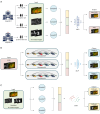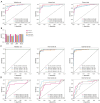Development and validation of the Artificial Intelligence-Proliferative Vitreoretinopathy (AI-PVR) Insight system for deep learning-based diagnosis and postoperative risk prediction in proliferative vitreoretinopathy using multimodal fundus imaging
- PMID: 40235812
- PMCID: PMC11994557
- DOI: 10.21037/qims-24-1644
Development and validation of the Artificial Intelligence-Proliferative Vitreoretinopathy (AI-PVR) Insight system for deep learning-based diagnosis and postoperative risk prediction in proliferative vitreoretinopathy using multimodal fundus imaging
Abstract
Background: Early diagnosis of proliferative vitreoretinopathy (PVR) is crucial for preventing vision loss and ensuring effective treatment of retinal detachment. This study developed and validated a system named Artificial Intelligence-Proliferative Vitreoretinopathy (AI-PVR) Insight, which aims to automate the identification, grading, and postoperative risk assessment of PVR.
Methods: We retrospectively collected data from 1,700 eyes of 1,700 patients who underwent vitrectomy at the Eye Hospital affiliated with Nanchang University and at Jiangxi Provincial People's Hospital from June 2015 to December 2023 for the development and validation of the AI-PVR Insight system performance. This system is based on two deep learning models, TwinsSVT and DenseNet-121, which extract features from three modalities: B-scan ultrasound (B-scan), optical coherence tomography (OCT), and ultra-widefield (UWF) retinal imaging. After principal component analysis (PCA) dimension reduction and feature fusion, multi-layer perceptron (MLP) or support vector machine (SVM) classifiers are used to identify PVR, assess severity, and predict postoperative risks. The performance of the system was evaluated by calculating area under the curve (AUC) values, accuracy, precision, recall, and F1 scores.
Results: The AI-PVR Insight system demonstrated exceptional performance in PVR identification and severity grading, with AUC values exceeding 0.957 (0.902, 1.000) on internal and external test sets, respectively. For predicting postoperative PVR risk, the system achieved AUC values above 0.827 (0.737, 0.916) on both test sets, respectively.
Conclusions: The AI-PVR Insight system has successfully achieved automatic identification, grading, and postoperative risk assessment of PVR, providing clinical physicians with support in formulating more targeted treatment plans and delivering critical insights for the effective prevention and management of PVR progression.
Keywords: Deep learning; multicenter; multimodal; proliferative vitreoretinopathy (PVR).
Copyright © 2025 AME Publishing Company. All rights reserved.
Conflict of interest statement
Conflicts of Interest: All authors have completed the ICMJE uniform disclosure form (available at https://qims.amegroups.com/article/view/10.21037/qims-24-1644/coif). The authors have no conflicts of interest to declare.
Figures




Similar articles
-
Predictive modeling of proliferative vitreoretinopathy using automated machine learning by ophthalmologists without coding experience.Sci Rep. 2020 Nov 11;10(1):19528. doi: 10.1038/s41598-020-76665-3. Sci Rep. 2020. PMID: 33177614 Free PMC article.
-
Ultra-Widefield OCT Images of Proliferative Vitreoretinopathy under Silicone Oil.Case Rep Ophthalmol. 2025 Jan 7;16(1):57-61. doi: 10.1159/000542391. eCollection 2025 Jan-Dec. Case Rep Ophthalmol. 2025. PMID: 39981537 Free PMC article.
-
Outcome of vitrectomy for advanced proliferative vitreoretinopathy complicating primary rhegmatogenous retinal detachment among Nigerians.Niger J Clin Pract. 2020 Mar;23(3):337-342. doi: 10.4103/njcp.njcp_158_19. Niger J Clin Pract. 2020. PMID: 32134032
-
Combined 5-Fluorouracil and Low Molecular Weight Heparin for the Prevention of Postoperative Proliferative Vitreoretinopathy in Patients With Retinal Detachment: A Meta-Analysis.Front Med (Lausanne). 2021 Nov 30;8:790460. doi: 10.3389/fmed.2021.790460. eCollection 2021. Front Med (Lausanne). 2021. PMID: 34917641 Free PMC article.
-
[Laser flare photometry for identification of high-risk patients for proliferative vitreoretinopathy].Ophthalmologe. 2018 Dec;115(12):1079-1083. doi: 10.1007/s00347-018-0777-y. Ophthalmologe. 2018. PMID: 30151741 Review. German.
Cited by
-
Deep learning-based classification of multiple fundus diseases using ultra-widefield images.Front Cell Dev Biol. 2025 Jul 17;13:1630667. doi: 10.3389/fcell.2025.1630667. eCollection 2025. Front Cell Dev Biol. 2025. PMID: 40746855 Free PMC article.
References
-
- Ikuno Y. Overview of the complications of high myopia. Retina 2017;37:2347-51. - PubMed
-
- Lingham G, Yazar S, Lucas RM, Milne E, Hewitt AW, Hammond CJ, MacGregor S, Rose KA, Chen FK, He M, Guggenheim JA, Clarke MW, Saw SM, Williams C, Coroneo MT, Straker L, Mackey DA. Time spent outdoors in childhood is associated with reduced risk of myopia as an adult. Sci Rep 2021;11:6337. 10.1038/s41598-021-85825-y - DOI - PMC - PubMed
LinkOut - more resources
Full Text Sources
Research Materials
